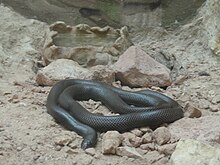Atractaspis engaddensis
| Atractaspis engaddensis | |
|---|---|
 |
|
| Atractaspis engaddensis | |
| Scientific classification | |
| Kingdom: | Animalia |
| Phylum: | Chordata |
| Class: | Reptilia |
| Order: | Squamata |
| Family: | Atractaspididae |
| Genus: | Atractaspis |
| Species: | A. engaddensis |
| Binomial name | |
|
Atractaspis engaddensis Haas, 1950 |
|
Atractaspis engaddensis is a venomous snake found in Sinai, Israel, Jordan, SW/C Saudi Arabia and Lebanon.
It is a venomous snake native to the Middle East and its body is usually dark black color and it has small eyes with round pupils. The tail is short and pointy. Its approximate size is one meter long.
They prefer hatchling snakes but they can also eat small mammals like young rodents.
Three isotoxins, named sarafotoxins S6a1, S6b and S6c, with strong cardiotoxic activity were isolated from the venom of a snake, Atractaspis engaddensis. All three sarafotoxins are homologous peptides (four or less than four residue replacements) consisting of 21 amino acid residues. Their structure and activity are novel among snake venom components. The venom from the snake Atractaspis engaddensis has a very high lethal potency, with an i.v. LD50 of 0.06-0.075 micrograms per g body weight in mice. The action of the venom is rapid and death results from seemingly neurotoxic effects. However, even at high concentrations, the venom does not block contractions of skeletal muscles that are directly or indirectly stimulated. The most prominent action of the venom is seen in the function of the heart in anesthetized mice, with or without artificial respiration. The changes observed in the ECG are similar to those recorded in human victims and are the result of an A-V block that is caused by an apparent direct action of the venom on the heart.
...
Wikipedia
